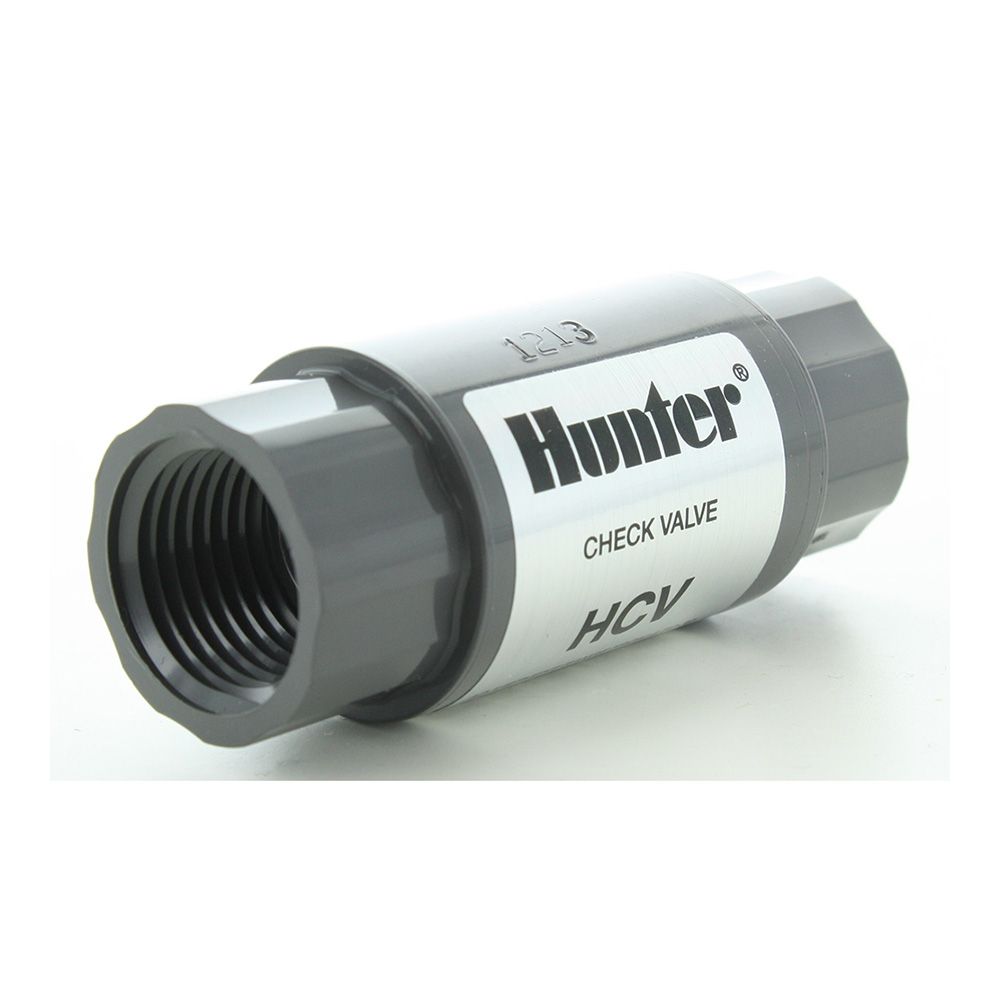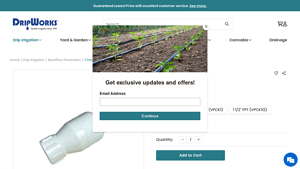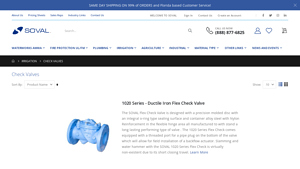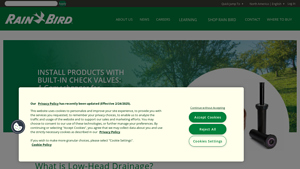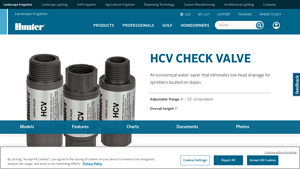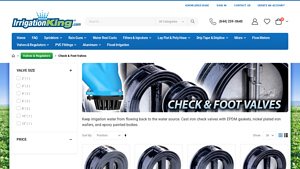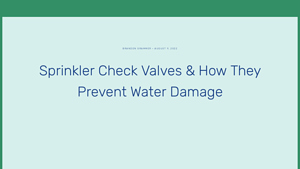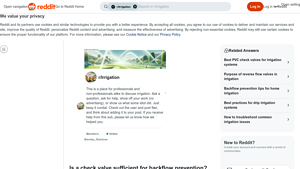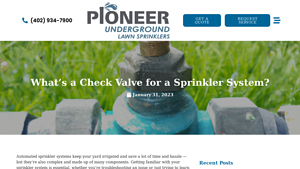Introduction: Navigating the Global Market for irrigation check valve
In the dynamic landscape of global agriculture, sourcing the right irrigation check valve has become a pivotal challenge for B2B buyers. As water scarcity intensifies across regions like Africa, South America, the Middle East, and Europe, the need for efficient irrigation systems is paramount. Check valves play a crucial role in preventing backflow, conserving water, and maintaining system pressure, thereby ensuring optimal irrigation performance. This guide aims to equip international B2B buyers with actionable insights into the diverse types of irrigation check valves available, their specific applications, and the importance of selecting reliable suppliers.
Navigating the intricacies of the irrigation check valve market can be daunting, especially when considering factors such as cost, durability, and compliance with regional regulations. This comprehensive guide delves into the various options on the market, from inline spring valves to foot valves, and highlights their respective benefits and ideal use cases. Additionally, it offers strategies for effectively vetting suppliers, ensuring that buyers can make informed decisions that align with their operational needs and sustainability goals. By empowering decision-makers with the knowledge they need, this resource aims to facilitate successful procurement processes that enhance irrigation efficiency and contribute to responsible water management practices worldwide.
Understanding irrigation check valve Types and Variations
| Type Name | Key Distinguishing Features | Primary B2B Applications | Brief Pros & Cons for Buyers |
|---|---|---|---|
| Inline Spring Check Valve | Automatically shuts off at low pressure; compact design | Residential and commercial irrigation | Pros: Space-saving, easy installation. Cons: Limited hold-back capacity compared to others. |
| Foot Valve | Prevents backflow in suction lines; maintains pump priming | Wells, ponds, and other water sources | Pros: Durable, effective for deep applications. Cons: Requires regular maintenance for longevity. |
| Silent Check Valve | Reduces water hammer; compact and economical design | Industrial and agricultural systems | Pros: Minimizes noise and wear; versatile installation. Cons: Higher initial cost. |
| Flanged Ball Check Valve | Allows flow in one direction; robust flanged design | Large-scale irrigation systems | Pros: High durability and flow capacity. Cons: More complex installation. |
| Built-in Check Valve | Integrated within other irrigation components | Drip irrigation and spray systems | Pros: Simplifies installation, saves space. Cons: Limited flexibility for upgrades. |
What Are the Key Characteristics of Inline Spring Check Valves?
Inline spring check valves are designed for automatic operation, ensuring they shut off water flow when pressure drops. Their compact design makes them suitable for both residential and commercial irrigation systems. B2B buyers should consider their ease of installation and space-saving benefits, although they may have a limited hold-back capacity compared to other types.
How Do Foot Valves Function in Irrigation Systems?
Foot valves are essential for preventing backflow in applications where water is drawn from wells or ponds. They maintain the priming of pumps, allowing efficient operation. Buyers in regions with deep water sources should prioritize foot valves for their durability and effectiveness. However, they require regular maintenance to ensure longevity, especially in environments with sediment.
What Benefits Do Silent Check Valves Offer?
Silent check valves are designed to minimize water hammer, making them ideal for industrial and agricultural irrigation systems. Their compact and economical design allows for versatile installation options. B2B buyers can benefit from reduced noise and wear on their systems, although the initial investment may be higher than traditional valves.
Why Choose Flanged Ball Check Valves for Large Systems?
Flanged ball check valves are robust and designed for high flow capacity, making them suitable for large-scale irrigation systems. Their flanged design allows for secure connections, essential in high-pressure environments. While they offer exceptional durability, the complexity of installation can be a drawback for some buyers.
What Are the Advantages of Built-in Check Valves?
Built-in check valves are integrated within other irrigation components, such as drip lines and spray heads, simplifying installation and saving space. They are particularly advantageous for modern irrigation designs. However, their integration can limit flexibility for future upgrades or replacements, a consideration for B2B buyers planning long-term irrigation solutions.
Key Industrial Applications of irrigation check valve
| Industry/Sector | Specific Application of Irrigation Check Valve | Value/Benefit for the Business | Key Sourcing Considerations for this Application |
|---|---|---|---|
| Agriculture | Drip Irrigation Systems | Enhances water efficiency and reduces wastage in crop irrigation. | Look for valves with high hold-back capability and durability. |
| Landscaping | Sprinkler Systems for Residential and Commercial Use | Prevents low-head drainage, protecting landscapes from erosion. | Ensure compatibility with existing systems and ease of installation. |
| Horticulture | Greenhouse Irrigation Systems | Maintains consistent water pressure, optimizing plant health. | Consider valves that can withstand varying environmental conditions. |
| Golf Course Management | Irrigation for Turf Management | Reduces water consumption and prevents uneven watering. | Evaluate valves for reliability and performance under pressure changes. |
| Municipal Water Management | Public Park and Recreational Area Irrigation | Conserves water and prevents infrastructure damage from flooding. | Check for compliance with local regulations and backflow prevention features. |
How is the Irrigation Check Valve Used in Agriculture?
In the agriculture sector, irrigation check valves are vital for drip irrigation systems. They prevent backflow and ensure that water flows only in the intended direction, which is crucial for maintaining efficient water use. This technology mitigates the risk of water pooling and soil erosion, particularly on sloped terrains common in many regions of Africa and South America. Buyers should prioritize sourcing valves that offer high durability and reliable hold-back capacity to meet the rigorous demands of agricultural applications.
What Role Do Irrigation Check Valves Play in Landscaping?
For landscaping, check valves are integral to sprinkler systems in both residential and commercial settings. They help eliminate low-head drainage, which can lead to unsightly puddles and soil erosion. This is particularly important in urban areas where landscaping aesthetics are paramount. Buyers should consider the compatibility of these valves with existing sprinkler systems, as well as their ease of installation, to ensure seamless integration and long-term performance.
How Do Check Valves Benefit Horticulture?
In horticulture, particularly in greenhouse irrigation systems, check valves maintain consistent water pressure, which is essential for plant health. By preventing backflow, these valves ensure that nutrient-rich water remains in the system, thereby optimizing growth conditions. Buyers from regions with varying climates, such as the Middle East and Europe, should look for valves that can withstand extreme environmental conditions and provide reliable performance throughout the growing season.
Why are Check Valves Important for Golf Course Management?
Golf course management relies heavily on irrigation systems to maintain turf quality. Check valves help minimize water consumption and ensure even distribution of water across the course. This is crucial for preventing damage to the turf and maintaining aesthetic appeal. When sourcing check valves for golf courses, buyers should evaluate their reliability and performance under variable pressure conditions to ensure optimal irrigation efficiency.
How Do Irrigation Check Valves Support Municipal Water Management?
Municipal water management systems utilize irrigation check valves in public parks and recreational areas to conserve water and prevent flooding. These valves help manage water flow effectively, reducing the risk of infrastructure damage caused by excess water accumulation. Buyers should ensure that the valves comply with local regulations and include features for backflow prevention to protect public water supplies from contamination, which is especially critical in densely populated regions.
3 Common User Pain Points for ‘irrigation check valve’ & Their Solutions
Scenario 1: Water Wastage Due to Low-Head Drainage
The Problem: Many B2B buyers operating irrigation systems face the challenge of low-head drainage, especially in properties with varied topography. When the irrigation system is turned off, residual water in the pipes flows downhill, exerting pressure at the lowest points. This phenomenon can lead to significant water wastage, causing pooling and potential erosion in landscaped areas. For businesses, this not only translates to higher water bills but also risks damaging valuable landscaping, ultimately impacting the aesthetics and functionality of the property.
The Solution: To combat low-head drainage effectively, buyers should prioritize the integration of high-quality irrigation check valves into their systems. When sourcing check valves, look for those specifically designed to handle elevation changes, such as the Rain Bird Seal-A-Matic™ check valve, which can hold back up to 14 feet of water. Proper installation at the lowest points in the irrigation system is crucial; this typically involves placing the valves close to sprinkler heads or emitters that are susceptible to drainage. By choosing products with superior hold-back capabilities, businesses can minimize water wastage and protect their landscaping investments, ensuring a more sustainable irrigation setup.
Scenario 2: Equipment Damage from Water Hammer
The Problem: Another significant pain point for B2B buyers is the occurrence of water hammer, a phenomenon that causes damaging shockwaves through the irrigation system when water flow is abruptly stopped. This can lead to premature wear and tear on pipes and valves, resulting in costly repairs and downtime. For irrigation managers, this not only disrupts operations but can also lead to service delays, negatively affecting client satisfaction and potentially losing business.
The Solution: To mitigate the risk of water hammer, buyers should consider installing check valves designed to minimize this issue. Products like the SOVAL 1036 Series Cast Iron Wafer Silent Check Valve are engineered to close quickly, preventing water from flowing back and reducing the risk of surges. When selecting check valves, ensure they are compatible with the specific pressure and flow requirements of your irrigation system. Regular maintenance, including inspections and timely replacement of worn components, will further enhance the longevity of the system and protect against water hammer-related damage.
Scenario 3: Backflow Contamination Risks
The Problem: In many regions, particularly in agricultural sectors, backflow contamination poses a serious risk to water quality. For B2B buyers involved in irrigation management, the potential for contaminated water entering the main supply due to backflow can lead to regulatory fines and health hazards. This concern is heightened in areas where irrigation systems are closely linked to potable water supplies, making it essential for buyers to take proactive measures to safeguard water quality.
The Solution: To address backflow risks, it is crucial to implement a comprehensive backflow prevention strategy that includes the use of dedicated backflow preventers alongside irrigation check valves. While check valves can help manage drainage, they do not replace the need for backflow prevention devices. Buyers should look for products that meet local regulations and standards, such as double-check valves or pressure vacuum breakers. Additionally, regular testing and maintenance of backflow prevention devices are essential to ensure they function correctly, providing peace of mind and compliance with health regulations. By investing in proper backflow prevention methods, businesses can protect their water supply and avoid costly penalties.
Strategic Material Selection Guide for irrigation check valve
What Materials Are Commonly Used for Irrigation Check Valves?
When selecting materials for irrigation check valves, it’s essential to consider their properties, performance, and suitability for specific applications. Here, we analyze four common materials used in the manufacturing of irrigation check valves: brass, stainless steel, PVC, and ductile iron.
How Does Brass Perform in Irrigation Check Valves?
Brass is a popular choice for irrigation check valves due to its excellent corrosion resistance and ability to withstand high temperatures and pressures. It typically has a temperature rating of up to 200°F (93°C) and can handle pressures up to 150 psi.
Pros: Brass is durable and offers good longevity, making it suitable for various irrigation applications. It is also relatively easy to machine, which simplifies manufacturing processes.
Cons: The primary drawback of brass is its cost, which is generally higher than plastic options. Additionally, brass may not be suitable for highly acidic or alkaline water, as these conditions can lead to corrosion over time.
Impact on Application: Brass check valves are compatible with potable water, making them ideal for residential and commercial irrigation systems. However, buyers in regions with aggressive water chemistry should consider this limitation.
Considerations for International Buyers: Compliance with standards such as ASTM B283 is crucial. Buyers from regions like Africa and South America should ensure that the brass used is lead-free to meet health regulations.
What Are the Advantages of Stainless Steel for Check Valves?
Stainless steel check valves are renowned for their outstanding corrosion resistance, especially in harsh environments. They can typically withstand temperatures up to 400°F (204°C) and pressures exceeding 300 psi.
Pros: The durability of stainless steel makes it suitable for long-term applications, and it is less likely to corrode than brass. This material is also highly versatile, working well with various media, including water, oils, and chemicals.
Cons: The primary disadvantage is the cost, as stainless steel is more expensive than both brass and plastic. Additionally, its weight can complicate installation and handling.
Impact on Application: Stainless steel check valves are ideal for agricultural and industrial applications where durability and resistance to harsh chemicals are necessary.
Considerations for International Buyers: Compliance with standards such as ASTM A312 is important. In regions like the Middle East, where extreme temperatures are common, stainless steel’s high-temperature tolerance is a significant advantage.
How Does PVC Compare for Irrigation Check Valves?
PVC (polyvinyl chloride) is a lightweight and cost-effective option for irrigation check valves. It is resistant to corrosion and can handle temperatures up to 140°F (60°C) and pressures around 150 psi.
Pros: The low cost and lightweight nature of PVC make it easy to handle and install. It is also resistant to a wide range of chemicals, making it suitable for various irrigation applications.
Cons: PVC can become brittle over time, especially when exposed to UV light or extreme temperatures. It also has a lower pressure rating compared to metals, which may limit its use in high-pressure systems.
Impact on Application: PVC check valves are commonly used in residential and commercial irrigation systems, particularly in regions with mild climates.
Considerations for International Buyers: Buyers should ensure compliance with local standards, such as ASTM D1784, and consider the potential need for UV protection in sunny regions like Brazil.
What Benefits Does Ductile Iron Offer for Check Valves?
Ductile iron is a robust material known for its strength and durability. It can withstand high pressures and temperatures, making it suitable for demanding irrigation applications.
Pros: Ductile iron check valves are resistant to wear and can handle high flow rates, making them ideal for large-scale irrigation systems. They also have good corrosion resistance when properly coated.
Cons: The weight of ductile iron can complicate installation and increase shipping costs. Additionally, it may require more maintenance to prevent rusting if not adequately protected.
Impact on Application: Ductile iron is often used in municipal and agricultural irrigation systems where high durability is required.
Considerations for International Buyers: Compliance with standards like ASTM A536 is essential. Buyers in Europe and the Middle East should consider the environmental impact of using iron and ensure proper coatings are applied.
Summary of Material Selection for Irrigation Check Valves
| Material | Typical Use Case for Irrigation Check Valve | Key Advantage | Key Disadvantage/Limitation | Relative Cost (Low/Med/High) |
|---|---|---|---|---|
| Brass | Residential and commercial irrigation | Excellent corrosion resistance | Higher cost, sensitive to water chemistry | High |
| Stainless Steel | Agricultural and industrial applications | Outstanding durability and versatility | High cost, heavier weight | High |
| PVC | Residential and commercial irrigation | Lightweight and cost-effective | Brittle over time, lower pressure rating | Low |
| Ductile Iron | Municipal and agricultural irrigation | High strength and durability | Heavy, requires maintenance | Medium |
This strategic material selection guide provides B2B buyers with essential insights into the properties, advantages, and limitations of common materials used in irrigation check valves. Understanding these factors will aid in making informed purchasing decisions tailored to specific applications and regional requirements.
In-depth Look: Manufacturing Processes and Quality Assurance for irrigation check valve
What Are the Key Stages in the Manufacturing Process of Irrigation Check Valves?
The manufacturing of irrigation check valves involves several critical stages that ensure the final product meets the required performance and durability standards. The primary stages include material preparation, forming, assembly, and finishing.
Material Preparation: How Are Raw Materials Selected and Prepared?
The selection of raw materials is pivotal in producing high-quality irrigation check valves. Manufacturers typically use materials such as brass, stainless steel, and ductile iron, chosen for their corrosion resistance and durability. The preparation process involves cutting, cleaning, and treating these materials to ensure they meet specific industry standards. For example, brass components may undergo a de-burring process to remove sharp edges and contaminants that could affect performance.
Forming: What Techniques Are Used to Shape the Components?
Once the materials are prepared, the forming process begins. This stage includes various techniques such as casting, forging, and machining. For instance, ductile iron check valves may be produced using a sand casting method, which involves pouring molten iron into molds to create the valve body. Precision machining is then applied to ensure that critical dimensions and tolerances are achieved, which is essential for the valve’s functionality. Advanced manufacturing technologies like CNC (Computer Numerical Control) machining are often employed to enhance precision and efficiency.
Assembly: How Are the Components Put Together?
After forming, the next step is assembly. This process involves fitting together various components such as the valve body, disc, and seals. Manufacturers typically utilize automated assembly lines to increase speed and consistency. During this stage, the components are often tested for fit and functionality before proceeding to the next phase. The use of precision tooling and fixtures helps ensure that each valve is assembled correctly, minimizing the risk of defects.
Finishing: What Final Touches Are Applied to Ensure Quality?
The finishing stage is where the valves receive their final treatments. This can include surface finishing processes like polishing, coating, and painting to enhance corrosion resistance and aesthetic appeal. Manufacturers may apply specialized coatings, such as epoxy or powder coating, to protect against environmental factors. Additionally, final inspections are conducted to check for any surface defects or inconsistencies.
What Quality Control Measures Are Essential for Irrigation Check Valves?
Quality assurance is a crucial aspect of the manufacturing process for irrigation check valves. Adhering to international and industry-specific standards ensures that the valves are reliable and safe for use in irrigation systems.
Which International Standards Should B2B Buyers Be Aware Of?
One of the most recognized international quality standards is ISO 9001, which outlines criteria for a quality management system. Compliance with ISO 9001 ensures that manufacturers consistently provide products that meet customer and regulatory requirements. For irrigation check valves, additional certifications such as CE marking in Europe and API (American Petroleum Institute) standards may also apply, depending on the application and market requirements.
What Are the Key Quality Control Checkpoints in the Manufacturing Process?
Quality control (QC) checkpoints are integrated throughout the manufacturing process to ensure product integrity. These checkpoints typically include:
Incoming Quality Control (IQC): This involves inspecting raw materials upon arrival to ensure they meet specified standards before production begins.
In-Process Quality Control (IPQC): During the manufacturing stages, periodic inspections are conducted to monitor processes and detect any deviations from quality standards. This includes checking dimensions, tolerances, and assembly accuracy.
Final Quality Control (FQC): After assembly and finishing, a comprehensive inspection is conducted to verify that each valve meets all performance criteria and regulatory requirements. This may involve pressure testing, leak testing, and functional testing.
How Can B2B Buyers Verify the Quality Control Processes of Suppliers?
When sourcing irrigation check valves, B2B buyers should take proactive steps to verify the quality control processes of potential suppliers. Here are some effective strategies:
What Should Buyers Look for in Supplier Audits and Reports?
Requesting detailed quality assurance reports and audit results from suppliers can provide insight into their QC practices. Buyers should look for evidence of compliance with international standards, as well as any certifications that demonstrate a commitment to quality. Regular audits conducted by third-party organizations can also validate the supplier’s adherence to quality standards.
How Can Third-Party Inspections Enhance Buyer Confidence?
Engaging third-party inspection services can further enhance buyer confidence. These independent entities conduct thorough evaluations of manufacturing processes, materials, and finished products. A third-party inspection can include random sampling of products to ensure they meet predefined specifications and standards. This step is particularly important for buyers in regions with strict regulatory environments, such as Europe.
What Unique QC Considerations Exist for International B2B Buyers?
B2B buyers from regions such as Africa, South America, the Middle East, and Europe must consider specific quality control nuances that may affect their purchasing decisions.
How Do Regional Regulations Impact Quality Standards?
Different regions have varying regulations regarding irrigation products. Buyers should familiarize themselves with local standards and requirements, such as those set by the European Union or specific countries. Understanding these regulations can help ensure compliance and avoid potential legal issues.
What Are the Challenges in Sourcing Quality Products Internationally?
Sourcing irrigation check valves from international suppliers can present challenges, including language barriers, time zone differences, and varying quality expectations. Buyers should establish clear communication channels and set detailed quality expectations upfront. Establishing long-term relationships with trusted suppliers can also mitigate these challenges, ensuring consistent quality and reliability in future orders.
Conclusion
In summary, understanding the manufacturing processes and quality assurance practices for irrigation check valves is essential for B2B buyers. By recognizing the key stages of manufacturing, quality control measures, and verification strategies, buyers can make informed decisions that align with their operational needs and sustainability goals. Prioritizing suppliers that adhere to international standards and demonstrate a commitment to quality will ultimately lead to more reliable and efficient irrigation systems.
Practical Sourcing Guide: A Step-by-Step Checklist for ‘irrigation check valve’
To assist B2B buyers in procuring irrigation check valves, this guide outlines essential steps to ensure an informed and efficient sourcing process. Whether you’re operating in regions like Africa, South America, the Middle East, or Europe, following these steps will help you select the right products and suppliers for your irrigation systems.
Step 1: Define Your Technical Specifications
Before initiating the procurement process, clearly outline your technical requirements for the irrigation check valves. Consider factors such as the flow rate, pressure ratings, and material compatibility with your existing irrigation system. This clarity will help you communicate effectively with suppliers and ensure that the valves meet your operational needs.
Step 2: Research Supplier Options
Conduct thorough research to identify potential suppliers who specialize in irrigation check valves. Look for companies with a strong reputation, especially in your target regions. Key aspects to investigate include:
– Product variety: Ensure they offer a range of valves suitable for different applications.
– Market experience: Suppliers with years of industry experience are often more reliable.
Step 3: Evaluate Supplier Certifications
Verify that potential suppliers possess the necessary certifications and quality assurance standards. Certifications such as ISO 9001 or local compliance markers indicate a commitment to quality and safety. This step is crucial for mitigating risks associated with product failures and ensuring that the valves meet regulatory requirements in your region.
Step 4: Request Samples and Technical Documentation
Before finalizing your order, request samples of the irrigation check valves along with technical documentation. This allows you to assess the quality and compatibility of the valves with your systems. Pay attention to:
– Installation guides: Ensure that the documentation provides clear installation and maintenance instructions.
– Performance data: Look for information on hold-back capacity and pressure ratings to confirm they meet your specifications.
Step 5: Assess Warranty and After-Sales Support
Inquire about the warranty terms and after-sales support provided by suppliers. A robust warranty indicates confidence in product quality and can significantly reduce your long-term costs. Additionally, reliable after-sales support can assist in troubleshooting and maintenance, ensuring your irrigation system operates smoothly.
Step 6: Review Pricing and Payment Terms
Gather quotes from multiple suppliers to compare pricing structures. Be mindful of any hidden costs related to shipping, handling, or taxes, particularly when importing from international suppliers. Evaluate payment terms to ensure they align with your budget and cash flow requirements, considering options like bulk purchase discounts.
Step 7: Finalize the Order and Confirm Delivery Timelines
Once you have selected a supplier, finalize the order details, including quantities, specific models, and delivery timelines. Confirm the shipping methods and expected arrival dates to avoid any disruptions in your irrigation projects. Clear communication at this stage helps establish a good relationship with the supplier, paving the way for future transactions.
By following these steps, B2B buyers can confidently procure irrigation check valves that meet their specific needs, ensuring optimal performance and sustainability in their irrigation systems.
Comprehensive Cost and Pricing Analysis for irrigation check valve Sourcing
What Are the Key Cost Components for Sourcing Irrigation Check Valves?
When considering the sourcing of irrigation check valves, understanding the cost structure is essential for effective budgeting. The primary cost components include materials, labor, manufacturing overhead, tooling, quality control (QC), logistics, and supplier margin.
Materials: The choice of materials significantly influences the cost. Common materials like brass, stainless steel, and PVC vary in price, durability, and corrosion resistance. For instance, brass valves generally cost more due to their longevity and resistance to wear compared to plastic alternatives.
Labor: Labor costs are tied to the complexity of the valve design and the skill level required for manufacturing. Custom valves may necessitate specialized labor, increasing overall costs.
Manufacturing Overhead: This includes expenses related to factory operations, such as utilities, depreciation of equipment, and indirect labor costs. Efficient manufacturing processes can help reduce overhead, thereby lowering the price for buyers.
Tooling: Initial tooling costs can be significant, especially for custom or specialized valves. However, once the tooling is established, the per-unit cost decreases with higher production volumes.
Quality Control: Rigorous QC processes are vital for ensuring product reliability. The costs associated with testing and certification can add to the overall price but are crucial for maintaining industry standards.
Logistics: Shipping and handling costs are influenced by the size and weight of the valves, as well as the distance from the manufacturer to the buyer. International shipping may incur additional tariffs and fees.
Margin: Suppliers typically include a margin that reflects their business model and market conditions. Understanding this margin can help buyers negotiate better pricing.
How Do Price Influencers Affect Irrigation Check Valve Costs?
Several factors can influence the pricing of irrigation check valves, making it crucial for buyers to understand their impact:
Volume/MOQ: The minimum order quantity (MOQ) can significantly affect the unit price. Larger orders generally qualify for bulk pricing discounts, allowing for better cost efficiency.
Specifications and Customization: Customized valves tailored to specific project needs may incur higher costs due to additional design and production efforts. Standardized products usually offer lower prices.
Materials and Quality Certifications: Higher-quality materials and certifications (like ISO or NSF) can increase costs. Buyers should weigh the benefits of quality against budget constraints.
Supplier Factors: Supplier reputation and reliability can influence pricing. Established suppliers may charge more due to their proven track record and customer service, while new entrants might offer competitive pricing to gain market share.
Incoterms: Understanding international commercial terms (Incoterms) is vital for cost calculation. They dictate the responsibilities of buyers and sellers regarding shipping, insurance, and tariffs, affecting the total landed cost.
What Are the Best Buyer Tips for Cost-Efficiency in International Sourcing?
To maximize cost-efficiency when sourcing irrigation check valves, particularly in regions like Africa, South America, the Middle East, and Europe, consider the following strategies:
Negotiate Effectively: Engage suppliers in discussions about pricing, especially if you can commit to larger orders. Leverage competitive quotes from multiple suppliers to create negotiation leverage.
Evaluate Total Cost of Ownership (TCO): Beyond the initial purchase price, consider the TCO, including installation, maintenance, and operational efficiency. Investing in higher-quality valves may lead to lower long-term costs through reduced failures and maintenance.
Stay Informed on Market Trends: Keep abreast of fluctuations in material costs and supply chain dynamics. Understanding global market trends can help you time your purchases for optimal pricing.
Consider Local Suppliers: For buyers in regions like Nigeria or Brazil, sourcing from local manufacturers can reduce logistics costs and lead times. This may also provide opportunities for better negotiation terms.
Assess Quality vs. Price: Balance the need for quality with budget constraints. While lower-priced valves might seem appealing, they could lead to higher costs through failures and replacements.
Disclaimer on Indicative Prices
Prices for irrigation check valves can vary widely based on the factors discussed. It is advisable to request quotes from multiple suppliers and conduct a thorough analysis to ensure that all cost components are considered before making a purchasing decision.
Alternatives Analysis: Comparing irrigation check valve With Other Solutions
Understanding Alternatives to Irrigation Check Valves
In the realm of irrigation systems, maintaining efficiency and preventing water wastage is paramount. While irrigation check valves are a common solution for preventing backflow and low-head drainage, various alternatives can also serve similar purposes. This analysis will compare irrigation check valves with foot valves and backflow preventers, providing insights into their respective benefits and limitations.
Comparison Table
| Comparison Aspect | Irrigation Check Valve | Foot Valve | Backflow Preventer |
|---|---|---|---|
| Performance | Prevents backflow and low-head drainage; maintains pressure effectively. | Allows water flow in one direction, keeping pumps primed. | Protects against contamination by preventing backflow. |
| Cost | Moderate initial investment; varies by brand and features. | Generally lower cost; effective for specific applications. | Higher upfront cost due to complex mechanisms. |
| Ease of Implementation | Relatively easy to install in various irrigation setups. | Simple installation, often used in well systems. | Requires professional installation and compliance with regulations. |
| Maintenance | Requires periodic checks for clogs or wear; generally low maintenance. | Minimal maintenance; may need cleaning to remove debris. | Regular inspections needed to ensure functionality and compliance. |
| Best Use Case | Ideal for systems with significant elevation changes or slopes. | Best suited for wells and water sources where pumps are used. | Essential for potable water systems where contamination is a concern. |
Detailed Breakdown of Alternatives
Foot Valves
Foot valves function similarly to check valves, primarily allowing water to flow in one direction while preventing backflow when pumps are off. They are typically installed at the bottom of a suction line, ensuring that the pump remains primed. The advantages of foot valves include their lower cost and ease of installation. However, they are most effective in specific scenarios, such as well systems, and may not provide the comprehensive protection against drainage issues that irrigation check valves do.
Backflow Preventers
Backflow preventers are crucial for safeguarding water supplies from contamination. They are designed to prevent the reverse flow of water, ensuring that potentially contaminated water does not enter the clean water supply. While they offer significant protection, backflow preventers typically come with a higher price tag and require professional installation to meet local regulations. Their complexity may also lead to increased maintenance requirements, making them less suitable for simple irrigation setups.
Conclusion: Choosing the Right Solution for Your Irrigation Needs
When selecting the appropriate solution for your irrigation system, it’s essential to assess your specific requirements and constraints. Irrigation check valves are an excellent choice for systems with varying elevations, ensuring efficient water usage and preventing wastage. Foot valves provide a cost-effective solution for pump systems, while backflow preventers are necessary for protecting potable water supplies. By considering factors such as performance, cost, ease of installation, and maintenance, B2B buyers can make informed decisions that align with their operational needs and sustainability goals.
Essential Technical Properties and Trade Terminology for irrigation check valve
What Are the Key Technical Properties of Irrigation Check Valves?
When selecting irrigation check valves, understanding their technical specifications is crucial for ensuring optimal performance in various environments, particularly in regions with unique topographies such as Africa, South America, the Middle East, and Europe. Here are essential specifications to consider:
Material Grade
Irrigation check valves are commonly made from materials like PVC, brass, and stainless steel. The choice of material affects durability, corrosion resistance, and suitability for specific water conditions. For example, stainless steel is preferred in saline environments, while PVC is more cost-effective for less demanding applications. Selecting the right material can extend the lifespan of the valve and reduce maintenance costs.Pressure Rating
The pressure rating, typically measured in pounds per square inch (PSI), indicates the maximum pressure the valve can withstand without failing. This specification is vital for ensuring the valve can handle the operational pressure of the irrigation system. In regions with fluctuating water pressures, opting for valves with higher pressure ratings can prevent leaks and system failures.Flow Rate
Measured in gallons per minute (GPM), the flow rate defines how much water can pass through the valve under specific conditions. Understanding the required flow rate is essential for matching the valve to the irrigation system’s design. A valve that does not meet the flow requirements can lead to inadequate irrigation coverage, resulting in crop damage or increased water usage.Hold-Back Capacity
The hold-back capacity refers to the valve’s ability to prevent backflow and maintain water in the system when it is turned off. This is particularly important in systems with elevation changes, where water can drain and cause erosion or uneven watering. Valves with higher hold-back capabilities help conserve water and minimize landscape damage.Size and Connection Type
The size of the valve must match the diameter of the irrigation pipes to ensure a proper fit and optimal flow. Additionally, connection types (such as threaded, flanged, or slip) must be compatible with the existing system. Proper sizing and connection ensure a seamless installation and can prevent future leaks.
What Are Common Trade Terms Related to Irrigation Check Valves?
Understanding industry terminology is essential for effective communication and negotiation in B2B transactions. Here are some common terms relevant to irrigation check valves:
OEM (Original Equipment Manufacturer)
This term refers to companies that produce parts or equipment that may be marketed by another manufacturer. When sourcing irrigation check valves, knowing whether a supplier is an OEM can help buyers understand product quality and compatibility with existing systems.MOQ (Minimum Order Quantity)
MOQ is the smallest quantity of a product that a supplier is willing to sell. This is crucial for B2B buyers, as understanding MOQ can impact inventory management and financial planning. For irrigation check valves, knowing the MOQ can help in budgeting for large projects.RFQ (Request for Quotation)
An RFQ is a document issued by a buyer requesting pricing and other details from suppliers for a specific product. For irrigation check valves, submitting an RFQ can help buyers gather competitive pricing and terms, facilitating informed purchasing decisions.Incoterms (International Commercial Terms)
These are standardized trade terms that define the responsibilities of buyers and sellers in international transactions. Familiarity with Incoterms is essential for ensuring clarity in shipping, insurance, and risk management related to irrigation check valves, especially when dealing with international suppliers.Backflow Prevention
This term refers to methods and devices that prevent contaminated water from flowing back into the clean water supply. While check valves assist in this process, they are not substitutes for dedicated backflow prevention devices. Understanding this distinction is critical for compliance with health regulations in irrigation projects.Water Hammer
Water hammer is a pressure surge that occurs when a fluid in motion is forced to stop or change direction suddenly. This phenomenon can cause significant damage to irrigation systems. Selecting check valves designed to mitigate water hammer can enhance system longevity and reliability.
By familiarizing yourself with these technical properties and trade terms, you can make more informed decisions when sourcing irrigation check valves, ultimately leading to more efficient and sustainable irrigation solutions.
Navigating Market Dynamics and Sourcing Trends in the irrigation check valve Sector
What Are the Current Market Dynamics and Key Trends in the Irrigation Check Valve Sector?
The global irrigation check valve market is witnessing significant growth, driven by the increasing demand for efficient water management systems. As climate change intensifies, regions like Africa, South America, the Middle East, and Europe are focusing on sustainable agricultural practices. This shift is creating a robust demand for irrigation solutions that minimize water wastage and enhance crop yield. The adoption of precision agriculture technologies, including smart irrigation systems equipped with advanced check valves, is gaining traction. These systems not only optimize water usage but also integrate with IoT devices for real-time monitoring and management.
Emerging B2B sourcing trends are leaning towards automation and digital platforms. Suppliers are increasingly leveraging e-commerce solutions to facilitate seamless transactions and improve supply chain visibility. Additionally, the integration of data analytics is enabling buyers to make informed decisions based on market trends and product performance. In regions like Nigeria and Brazil, the focus on localized sourcing is becoming prominent, as businesses seek to reduce logistics costs and improve delivery timelines. Furthermore, partnerships with local manufacturers are fostering innovation tailored to specific regional challenges, such as varying soil types and climate conditions.
How Can Sustainability and Ethical Sourcing Impact the Irrigation Check Valve Market?
Sustainability is becoming a pivotal factor in the irrigation check valve sector, as buyers increasingly prioritize environmental responsibility in their procurement processes. The production of check valves using eco-friendly materials and processes is gaining importance, with manufacturers exploring options like recycled metals and lead-free alloys. Additionally, certifications such as ISO 14001 and the WaterSense label are becoming essential for suppliers aiming to demonstrate their commitment to sustainability.
Ethical sourcing practices are equally crucial, especially in regions with stringent regulations regarding labor and environmental standards. Buyers are encouraged to scrutinize their supply chains to ensure compliance with ethical sourcing guidelines. This not only enhances brand reputation but also mitigates risks associated with supply chain disruptions. For instance, sourcing from suppliers who adhere to fair labor practices and sustainable manufacturing processes can lead to long-term partnerships and customer loyalty. As global awareness of environmental and social issues grows, B2B buyers in the irrigation check valve market must align their sourcing strategies with sustainability goals to remain competitive.
How Has the Irrigation Check Valve Industry Evolved Over Time?
The irrigation check valve industry has undergone significant evolution over the past few decades. Initially, check valves were primarily mechanical devices designed to prevent backflow and ensure the efficiency of irrigation systems. However, advancements in materials science and engineering have led to the development of more sophisticated products, such as those incorporating built-in check valve technology that offers enhanced performance in preventing low-head drainage.
The introduction of smart technologies has further transformed the sector, allowing for real-time monitoring and automated control of irrigation systems. This evolution reflects a broader trend towards precision agriculture, where efficiency and sustainability are paramount. As the market continues to evolve, buyers can expect innovations that not only improve the functionality of irrigation systems but also contribute to broader environmental and economic goals.
Frequently Asked Questions (FAQs) for B2B Buyers of irrigation check valve
How do I solve low-head drainage issues in my irrigation system?
To address low-head drainage, which occurs when water flows back downhill after the system shuts off, installing check valves at strategic low points in your irrigation system is essential. Check valves prevent this backflow, ensuring that water remains in the lines and reducing wastage. Look for models with high hold-back capacity, as they can handle significant elevation changes and maintain pressure in your system. Regular maintenance of these valves will also help in preventing any potential leaks or malfunctions.What is the best check valve for preventing erosion in sloped landscapes?
For sloped landscapes, a check valve with a high hold-back capacity is crucial. Products like the Seal-A-Matic™ Check Valve from Rain Bird can hold back up to 14 feet of water, effectively minimizing the risk of erosion caused by low-head drainage. Additionally, consider valves designed to handle varying pressures and those that feature durable materials to withstand environmental conditions. Choosing the right valve not only conserves water but also protects your landscape from damage.What should I consider when sourcing irrigation check valves from international suppliers?
When sourcing irrigation check valves internationally, consider factors such as the supplier’s reliability, product certifications, and compliance with local regulations. Verify their manufacturing practices, as quality standards can vary widely. Additionally, assess their capacity for customization to meet specific project requirements and inquire about their experience in shipping to your region. It’s also wise to request samples before placing larger orders to ensure product quality and compatibility with your systems.What are common payment terms for international B2B transactions involving irrigation check valves?
Payment terms can vary widely depending on the supplier and your negotiation. Common terms include Letters of Credit (LC), advance payments, or 30-60 day payment terms after delivery. Always clarify terms upfront and consider using secure payment methods to protect your investment. Establishing a solid relationship with the supplier can also lead to more favorable payment conditions over time, especially for repeat orders.How can I ensure the quality of irrigation check valves before purchase?
To ensure quality, request product certifications and third-party testing reports from your supplier. You can also ask for references from previous clients or case studies showcasing their products in similar applications. Conducting a factory visit or utilizing a third-party inspection service can provide additional assurance. Additionally, inquire about warranty policies and the supplier’s commitment to post-sale support, as these factors can significantly impact product reliability.What are the minimum order quantities (MOQs) for check valves, and how do they affect pricing?
Minimum order quantities (MOQs) for irrigation check valves can vary by supplier, typically ranging from 50 to several hundred units. Larger orders often lead to reduced per-unit pricing, making it crucial to balance your immediate needs with potential future demand. If your project requires fewer units, discuss potential for sample orders or negotiate MOQs with the supplier. Understanding these quantities will help you manage your budget effectively while ensuring you have adequate stock for ongoing maintenance.How do I vet suppliers of irrigation check valves for reliability?
Vetting suppliers involves checking their industry reputation, years in business, and customer reviews. Look for suppliers with a strong track record in your geographic region and those who have experience with similar projects. Requesting references and checking their response times and customer service quality during initial communications can also provide insights into their reliability. Additionally, engaging in trade shows or industry events can help you meet suppliers in person and assess their capabilities.What logistics considerations should I keep in mind when importing check valves?
When importing check valves, consider shipping methods, lead times, and potential customs duties or tariffs in your country. Ensure that your supplier is aware of your logistical needs and can provide accurate shipping timelines. It’s also essential to have a clear understanding of the import regulations in your region, including any required documentation. Collaborating with a reliable freight forwarder can streamline the process and help mitigate potential delays or complications during shipping.
Important Disclaimer & Terms of Use
⚠️ Important Disclaimer
The information provided in this guide, including content regarding manufacturers, technical specifications, and market analysis, is for informational and educational purposes only. It does not constitute professional procurement advice, financial advice, or legal advice.
While we have made every effort to ensure the accuracy and timeliness of the information, we are not responsible for any errors, omissions, or outdated information. Market conditions, company details, and technical standards are subject to change.
B2B buyers must conduct their own independent and thorough due diligence before making any purchasing decisions. This includes contacting suppliers directly, verifying certifications, requesting samples, and seeking professional consultation. The risk of relying on any information in this guide is borne solely by the reader.
Top 8 Irrigation Check Valve Manufacturers & Suppliers List
1. DripWorks – Check Valves
Domain: dripworks.com
Registered: 1998 (27 years)
Introduction: Check Valves – Price Range: $16.95 – $34.95. SKU: Q_VPCK. Configuration Options: 3/4″ FPT, 1″ FPT, 1 1/2″ FPT, 2″ FPT. Weight: 1/2 pound internal spring. Features: One-way check valves prevent water from flowing back into the home water supply during sudden pressure loss; can be installed on downward slopes to prevent water drainage; commonly used in pump systems to eliminate back pressure. Note: …
2. Soval – 1020 Series Flex Check Valve
Domain: soval.com
Registered: 1997 (28 years)
Introduction: Check Valves – Irrigation
1. **1020 Series – Ductile Iron Flex Check Valve**
– Precision molded disc with integral o-ring sealing surface.
– Container alloy steel with Nylon reinforcement.
– Threaded port for backflow actuator installation.
– Virtually eliminates slamming and water hammer.
2. **1036 Series – Cast Iron Wafer Silent Check Valve**
– Economical and compact body design…
3. Rain Bird – Check Valves
Domain: rainbird.com
Registered: 1995 (30 years)
Introduction: Check valves from Rain Bird are designed to prevent low-head drainage, conserve water, and protect irrigation systems. Key features include:
– Hold-back capacity: Capable of holding back 8 to 14 feet of water, depending on the product.
– Benefits: Conserves water, prevents overwatering, minimizes land erosion, reduces wear on the system, guards against backflow contamination, protects against prop…
4. Hunter – HCV Check Valve
Domain: hunterirrigation.com
Registered: 2001 (24 years)
Introduction: HCV Check Valve from Hunter Industries is an economical water-saver designed to eliminate low head drainage for sprinklers located on slopes. Key specifications include: adjustable range of 4′ – 32′ of elevation, overall height of 3 inches, and constructed to schedule 80 specifications for durability. Available models include HC-50F-50F (½” female inlet x ½” female outlet), HC-50F-50M (½” female i…
5. Irrigation King – Cast Iron Check Valve
Domain: irrigationking.com
Registered: 2016 (9 years)
Introduction: Cast Iron Check & Foot Valves: Keep irrigation water from flowing back to the water source. Features include cast iron construction with EPDM gaskets, nickel plated iron wafers, and epoxy painted bodies. Available sizes and prices: 2″ Cast Iron Wafer Check Valve – Double Wing RKCV-2: was $101.36, special price $42.23; 3″ Cast Iron Wafer Check Valve – Double Wing RKCV-3: was $176.93, special price …
6. Commercial Lawn Irrigation – Sprinkler Check Valves
Domain: commerciallawnirrigation.com
Registered: 2009 (16 years)
Introduction: Sprinkler check valves prevent excess water from leaking out of sprinkler systems, conserving water and preventing damage. They work by automatically opening and closing a disc based on water pressure, ensuring water flows in one direction. Pre-installed check valves are recommended for efficient operation, while post-installation may be needed for some systems. Benefits include preventing pooling…
7. Reddit – 3/4 PVC Check Valves for Drip Irrigation
Domain: reddit.com
Registered: 2005 (20 years)
Introduction: 3/4″ PVC check valves for sale for <$10; intended for use in drip irrigation systems to prevent backflow into the home.
8. Pioneer Underground – Check Valve for Sprinkler Systems
Domain: pioneerunderground.net
Registered: 2010 (15 years)
Introduction: A check valve for a sprinkler system is a critical component that regulates water flow, protects the potable water supply, and maintains optimal system efficiency. It is designed to allow flow from one direction while blocking backflow, preventing potentially contaminated water from returning to the water supply. Check valves can be installed individually or in groups and can be adjusted to regula…
Strategic Sourcing Conclusion and Outlook for irrigation check valve
What Are the Key Benefits of Investing in Quality Irrigation Check Valves?
In conclusion, the strategic sourcing of irrigation check valves represents a pivotal opportunity for B2B buyers across Africa, South America, the Middle East, and Europe. These valves are essential for preventing water wastage through low-head drainage, maintaining system pressure, and ensuring the longevity of irrigation systems. By selecting high-quality products with superior hold-back capabilities, such as those from reputable manufacturers, businesses can significantly enhance water conservation efforts while minimizing landscape damage and equipment wear.
How Can International Buyers Leverage Strategic Sourcing for Competitive Advantage?
The value of strategic sourcing cannot be overstated; it empowers buyers to negotiate better terms, access innovative technologies, and align purchasing strategies with sustainability goals. As the global focus on water conservation intensifies, investing in advanced irrigation solutions will not only improve operational efficiency but also contribute to corporate social responsibility initiatives.
What’s Next for B2B Buyers in the Irrigation Sector?
Looking ahead, it is crucial for international buyers to stay informed about evolving technologies and market trends in the irrigation sector. Engage with suppliers, attend industry trade shows, and consider integrating check valves into your irrigation designs to enhance system performance. Make the strategic move today to ensure your operations are sustainable, efficient, and prepared for future challenges.

